Information about the 70mm
Cinerama movie |
Read more at in70mm.com The 70mm Newsletter |
| Written by: Gerhard Witte, Berlin | Date: 01.01.2016 |
HUNGARY welcomes International Productions! |
|
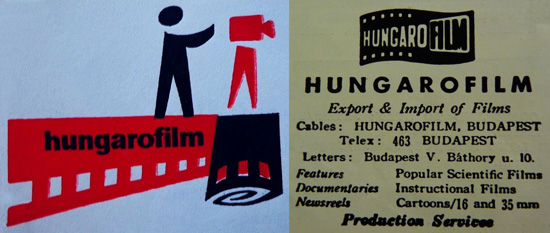 Hungarofilm advertisements from the 1960s. At the time, the bureau was in
the eastern part of the city (in "Pest") near the famous and impressive
Hungarian Parliament Building which is located on the bank of the Danube. Hungarofilm advertisements from the 1960s. At the time, the bureau was in
the eastern part of the city (in "Pest") near the famous and impressive
Hungarian Parliament Building which is located on the bank of the Danube.From "Hungarofilm Revue" No. 1 / 1965 For ten years, Hungarofilm has paved the way for Hungarian films in many different directions in the world, while also providing Hungarian cinemas with foreign films. During this time, Hungarian films have made it into around 80 countries – movies as well as short films – and the names of the most important filmmakers and the best works by Hungarian directors have become known. Hungarofilm has recently opened up its activities into a new area besides film export and import. The Hungarian film studios are opening up to foreign producers and, although these relationships are only in the early stages, we can already report on some noteworthy companies. Apart from Walt Disney Productions and CINERAMA, Inc., many German and French film production companies and television production companies have visited Hungary. |
More in 70mm reading: Gerhard Witte's in70mm.com Library • "The Golden Head" revisited Millie goes to the Golden Head • Jess Conrad in Karlsruhe Internet link: Remastered "Golden Head" trailer Jess Conrad's website "incinerama.com" informs about the movie "The Golden Head" List of Hungarian films American Widescreen Museum |
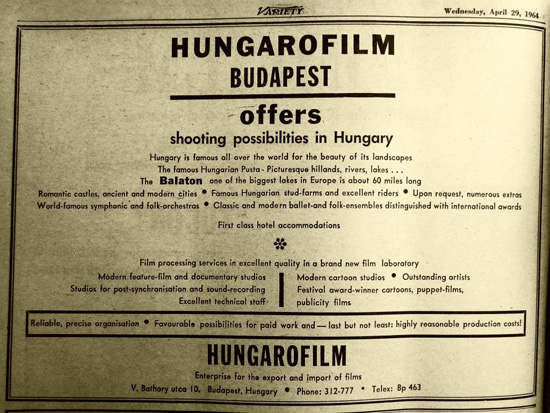 An advert in "New York VARIETY" dated Wednesday, April 29, 1964. An advert in "New York VARIETY" dated Wednesday, April 29, 1964.Hungarofilm Budapest offers: Shooting possibilities in Hungary – Hungary is famous all over the world for the beauty of its landscapes. The famous Hungarian Puszta – Picturesque hill lands, rivers, lakes – The Balaton one of the biggest lakes in Europe is about 60 miles long. Romantic castles, ancient and modern cities – Famous Hungarian stud farms and excellent riders – Upon request, numerous extras – World-famous symphonic and folk orchestras – Classic and modern ballet and folk ensembles distinguished with international awards – First class hotel accommodations – Film processing services in excellent quality in a brand new film laboratory – Modern feature film and documentary studios – Modern cartoon studios – Outstanding artists – Studios for post synchronization and sound recording – Festival award winner cartoons, puppet films – Excellent technical staff – Publicity films – Reliable, precise organization – Favorable possibilities for paid work and last but not least: Highly reasonable production costs! Hungarofilm Enterprise for the export and import of films (V. Báthory utca 10, Budapest, Hungary) An extract taken from an article in "New York VARIETY" dated Wednesday, October 30, 1963: Budapest, Oct. 22 – "Milly" in Cinerama Process Considered Milestone for Hungary's Industry. The Hungarian film industry, drawing new international attention on account of its co-production with Cinerama of "Milly goes to Budapest", has a well-established and active production and distribution setup going. Annual production averages 20 features plus some 150 newsreels, 50 cartoons and educational shorts. Prior to the Cinerama partnership, there were two co-productions with French outfits, namely: "The Lady and the Gypsy" and "Germinal", one with "Misr" Studio of Cairo (author's comment: Or "Masr" as Egyptians pronounce it – meaning Egypt), "Two Kids and the Pyramids", and two others with the Czechoslovak film combine, "St. Peter's Umbrella" and "Every Day – Sunday". All were filmed for widescreen. There is no Cinerama installation in Hungary, but since "Milly goes to Budapest" is being filmed by the new single-lens system of Cinerama it is expected that the picture will be shown in CinemaScope instead. |
|
The Filming of "The Golden Head" |
|
|
The movie's producer, the Hungarian-born
Alexander Paal (1910 – 1972), selected for production the British crime
novel called "Nepomuk of the River" written by Roger Windle Pilkington (1915
– 2003), but the final script was in the end only loosely based on the book.
The project started as a Hungarian-British co-production. The British
Stanley Goulder (1921 – 2006) and the Hungarian Iván Boldizsár (1912 – 1988)
wrote the screenplay. Shooting began 1963 at MGM's British Borehamwood
Studios located northwest of London – read Tony Sloman's report on
in70mm.com: "The Golden Head" Revisited – and then in late summer / autumn
in Hungary. Principal photography ended in Hungary on Thursday, November 21,
1963. Further interior shots were carried out at Shepperton Studios
located southwest of London. At the time, the movie's working title had
been: "Milly goes to Budapest". Alexander Paal managed that Robert H. O´Brien, president of MGM, and Nicolas Reisini, president and chairman of Cinerama, Inc. agreed to back the project from the States, with Hungarofilm and Hunnia Filmstúdió supporting from Budapest. Previously, MGM and Cinerama, Inc. had already gained filming experience in Europe with their 3-strip Cinerama movie "The Wonderful World of the Brothers Grimm" (USA, 1962). During filming, Alexander Paal co-operated with Cinerama's William R. Forman (1913 – 1981) and Coleman Thomas Conroy, Jr., who as the movie's executive producer had been in overall charge for the Americans. By the way, end of 1963, the owner of the Pacific Coast Theater chain, William R. Forman, purchased Cinerama, Inc. and became president and chief executive officer of Cinerama, Inc. He succeeded Nicolas Reisini who wanted to continue as board chairman. A short interesting article in "New York VARIETY" dated Wednesday, September 25, 1963: Revamp Hungary-shot Comedy in Cinerama. "Milly goes to Budapest", Cinerama comedy now going in Hungary, reportedly has been "reorganized" as a straight Cinerama entry. Film had started out as a co-production with Dimitri de Grunwald who now has disassociated from the film. Unclear is whether Nicolas Reisini, Cinerama president-chairman, will take producer's credit. Author's comment: Dimitri de Grunwald (1914 –1990) was a Russian-born producer of films in Britain during the 1960's and 70's. He also made the short subject "Shellarama" shot on behalf of the Shell Petroleum Company in Technirama (UK, I965). "The Golden Head's" all producers were: Coleman Thomas Conroy, Jr. (executive producer) / William R. Forman (producer) / András Németh (I), associate producer for the IV. Art-Group of the Hunnia Filmstúdió / Alexander Paal (producer). When shooting began, the British director James Hill (1919 – 1994), a respected filmmaker, e.g., "Born Free" (UK, USA, 1966) / Oscar for his short "Giuseppina" (UK, 1960), was commissioned to helm the project. Primarily, the movie had been planned as a 3-strip Cinerama presentation. Photographed in majestic Budapest and presented on huge deeply curved Cinerama screens, "The Golden Head" could have been a great incentive for Hungarian tourism and a guarantee for a worldwide market in first-class theatres. The project was officially to be an MGM and Hunnia Filmstúdió co-production and Cinerama and Hungarofilm (Magyar Film) were the "presenters". The Hunnia Filmstúdió (Malfilm) is still existing, located in the eastern part of the city – in "Pest". At the time, Cinerama, Inc. already owned nine feature movies, which were originally shot in the 3-strip process : "This in Cinerama" (1952), "Cinerama Holiday" (1955), "Seven Wonders of the World" (1956), "Search for Paradise" (1957), "South Seas Adventure" (1958), "Windjammer: The Voyage of the Christian Radich" (1958 – already end of 1959, Cinerama Inc. acquired the assets of the rival Cinemiracle Corporation), "The Best of Cinerama" (1962), "The Wonderful World of the Brothers Grimm" (1962) and "How the West Was Won" (1962). The ownership of the last two narrative movies was shared 50-50 between MGM and Cinerama, Inc.. "The Golden Head" should now be the 10th film. Additional Information: In the 1960s, Cinerama, Inc. owned further 3-strip prints of two of its feature movies, namely: 1.) "Scent of Mystery" (USA, 1960) shot on 65mm film stock, acquired from Michael Todd, Jr. – so, not really a 3-strip movie. For its re-opening the movie had been shortened and also converted for 3-strip projection (70mm and few 3-strip prints - without smells) now renamed "Holiday in Spain" (USA, 1961), and 2.) "Cinerama's Russian Adventure" (USSR/USA, 1966) – it is said, only one 3-strip print for the movie's World Premiere. Meanwhile, the films have been reconstructed / remastered from surviving 65mm and 70mm elements. |
|
 Adverts taken from the Hungarian newspaper "Népszabadság" from that time. Adverts taken from the Hungarian newspaper "Népszabadság" from that time.Already at beginning of the "Golden Head's" shooting phase there had been problems. Robert E. Carr and R.M. Hayes write in their book "Wide Screen Movies": "Production problems immediately arose around the director James Hill. He was not getting along well with the Hungarians and was completely at odds with the Americans. Filming was halted and Nicholas Reisini flew with his advisers to Budapest." Ultimately, Hill was replaced by the American director Richard Thorpe (1896 – 1991), well-known for his long career at MGM, and shooting took off at an accelerated pace. The three-panel process was abandoned in favor of Super Technirama-70 and some or all of Hill's scenes were re-shot. Due to the decision to shoot the movie in anamorphic Technirama film format (horizontal on 8-perf- 35mm wide-gauge negative film), "The Golden Head" is the first single lens production made by Cinerama itself (70mm Cinerama), and is the first film made in Hungary to utilize 70mm widescreen technology. Some scenes in the film, e.g., the chase sequences over the Elizabeth Cable Bridge, which was under construction at the time, were filmed with the German-made, manageable M.C.S. 65mm Reflex "Field Camera" in M.C.S-70 Superpanorama. The Elizabeth Bridge was completed late in 1964 and is one of the meanwhile twelve connections in the capital between Buda and Pest across the Blue Danube. Read an extract from an interview did by Bob Thomas in California with the comic Buddy Hackett (1924 – 2003), "Lionel Peck" in the movie, published in "Lewiston Evening Journal" on Monday, December 09, 1963: From the halls of Budapest to the shores of Malibu is Buddy's latest Screen Odyssey. "In Hungary I became almost a national hero that's because I was the only visitor who tried to learn their language. Everywhere I went I talked to people and tried to make them laugh. I would tell them in their own language: `The Hungarian people are all heart´ - and they are, but I couldn't get over the miserable way they had to live. It was terribly depressing, yet I suppose it could be worse. I never had a bad meal. They have all kinds of goulash and wonderful fish and a fish soup that I loved. It was so hot it made my mother's horseradish taste like sour cream. The first six weeks of filming were wasted, because of foul-ups with a British company which was also co-producing. The British pulled out, and then production moved more smoothly under the direction of Richard Thorpe, a speed-minded MGM veteran. The studio was built by Alexander Korda in 1928, and it is on par with studios in Hollywood, where many are of the same vintage. But there was no incentive among the set workers – they all earn the same salary." After the end of filming, the movie's mixing and dubbing were carried out in England / London start of 1964, and the retitled "The Golden Head" was ready for premiere – but not in England! What said Buddy Hackett in the interview: "The British company which was also co-producing pulled out". |
|
The movie's first release took place in Budapest on Thursday, December 10, 1964 |
|
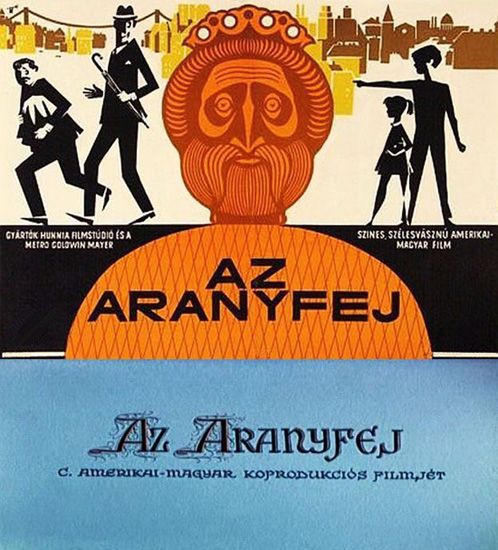 This is a Hungarian commercial art of the movie "The Golden Head". Below:
The title sequence from the Hungarian 35mm widescreen version of the movie. This is a Hungarian commercial art of the movie "The Golden Head". Below:
The title sequence from the Hungarian 35mm widescreen version of the movie.It opened on 10.12.1964 with optically reduced 35mm prints, most likely in anamorphic CinemaScope film format, in 5 Budapest cinemas (see advert) named: A.) "Szikra", B.) "Bartók", C.) "Május 1", D.) "Sport" and E.) "Kossuth", located in borough XX: Pesterzsébet. In the advert on the right side is written [see above, editor]: December 10-i filmbemutatók: "Az Aranyfej" – Szines amerikai-magyar film – Széles változatban is Gyártó cég: Hunnia Filmstúdió és Cinerama, Inc. – Csak a moziban látható, a tv nem közvetiti. Screenings from December 10th: "The Golden Head" – a Hungarian-American film in color – produced in widescreen format by Hunnia Filmstúdió and Cinerama, Inc. – only in cinemas, on TV not effective. Cyártók Hunnia Filmstúdio és a Metro Goldwyn Mayer – Színes, Szélesvásznú, Amerikai-Magyar Film. Cyártók Hunnia Filmstúdió and Metro Goldwyn Mayer – Colour, Widescreen, an American-Hungarian film. A review about the movie written by István Tamás published in the Hungarian newspaper "Népszabadság" on Thursday, December 17, 1964. For readers in Hungary here first the original version followed by the English translation: |
|
Filmekröl: Magyar – amerikai film "Az aranyfej" |
|
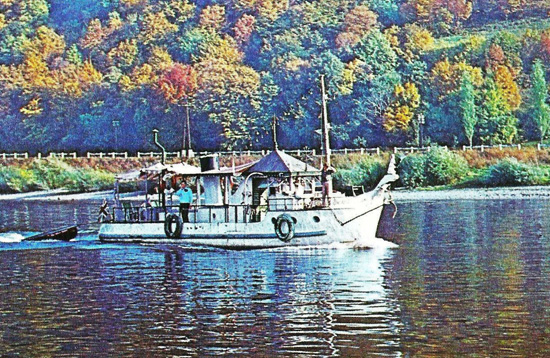 The Hungarian-made all-metal steam ship "White Rabbit" travelling down the
Danube (image taken from the movie's souvenir brochure). Read Wolfram
Hannemann's interesting film introduction about the movie, which was
screened in Germany on the occasion of the 6th
Todd-AO Festival at the Schauburg Cinerama Theatre in Karlsruhe in 2010 The Hungarian-made all-metal steam ship "White Rabbit" travelling down the
Danube (image taken from the movie's souvenir brochure). Read Wolfram
Hannemann's interesting film introduction about the movie, which was
screened in Germany on the occasion of the 6th
Todd-AO Festival at the Schauburg Cinerama Theatre in Karlsruhe in 2010Játszik, nincs szerencsénk a koprodukciókkal. Emlékezhetünk, a Fekete szem éjszakája egy árnyalattal "liraibbra" sikerült annál, mint amit jó izlésü ember el tud viselni, az Egyiptomi történetet sem fogja senki a világ nagy filmalkotásai között méltatni, feltehetöleg a Pirosbetüs hétköznapokat sem… s most itt van "Az aranyfej". Ez is igen rossz film. A forgatókönyvirók nehéz helyzetét megértjük; nem egyszerü feladat úgy megkomponálni egy játékfilm cselekményét, hogy legyen benne ritmus, báj és könnyedség, humor, zene és látvány – s ugyanakkor bemutassa hazánk természeti szépségeit, éjjel és nappal a Dunát, karcsú hidjainkat, nemzetközi luxushotel-jeinket, amelyek a legkényesebb turisták igényeit is kielégitik, de ne mulassza el felhivni a külföldi nézó figyelmét arra sem, hogy Magyarországon van még gulyás, fokos, halászlé is, s jó karban tarott székesegyház, plébánossal. E sok szempontot a két forgatókönyviró, Stanley Goulder és Boldizsár Iván nagy filmirói gyakorlattal s kecses politikai rutinnal ötvötze össze; a leltárban a legaggályosabb könyvvizsgáló sem találna hiányt. Minden benne van. Hiányzó tételként talán a müvészetet emlithetnénk meg, ha értelmét találnánk eröszakolt kapcsolatok keresésének. A filmet a Cinerama, Inc. amerikai társaság Cinerama elöadásra szánta (a nézötéren félkörivben körülfutó vászon). Igy valószinüleg még teljesebb lehet a hatás, nálunk azonban csak a szélesvásznú változatot játsszák a mozik, a hiányzó felületeket tehát képzeletünkkel kell kitölteni: milyen lehet, ha jobbról-balról is locsog a Duna, ha az Ŕllami Népi Együttes lakodalmas tánca több dimenzióban jelenik meg a visegrádi éjszakában… és igy tovább (meg kell azonban jegyezni, hogy István Hildebrand képei a szokásos széles változatban is szépek, gazdagok, eredetiek). A történetet a fenti sémáknak megfelelóen bonyolitották le, Mr. Stevenson angol kriminalista, Fehér Nyuszi nevü karcsú jachtján, elbüvölö gyermekei társaságában érkezik Magyarországra, hogy részt vegyen a nemzetközi bünügyi konferencia ülésén: a Stevenson családdal egy idöben lépi át az országhatárt két nemzetközi tolvaj, és elrabolják a györi székesegyház nagy értékü Szent László hermáját – a gyanú a jacht utasaira terelödik, végül azonban Mr. Stevenson gyermekei, miközben atyjuk a konferencián szónokol, visszaszerzik a kincset, leleplezik a tolvajokat. Richard Thorpe rendezte a filmet: úgy, ahogy ezt a filmet rendezni kellett. Van benne sok játékos-kedves ötlet, báj és üdeség is – ám nehéz megszabadulni attól a gondolattól, hogy nem leit volna-e egyértelmúbb s helyesebb dolog, akár egyedi, akár koprodukcióban látványos idegenforgalmi filmet késziteni Magyarországról? Amely éppúgy idegenforgalmi reklámfilm volna, mint ez. csak alkotója nem lenne kitéve a kinos gyanúsitgatásnak, hogy bele akarták keverni a müvészetet. Kitünöek "Az aranyfej" szereplöi, Buddy Hackett, George Sanders, Robert Coote nevét kell elsösorban dicsérettel megemliteni, és a kedves kis gyerek szinésznö, Lorraine Power. A magyar szereplök közül Esztergályos Cecilia, Pécsi Sándor, Maklári Zoltán, Ungvári László tünik fel egy-egy pillanatra; s nagyon jó a Szakállas szerepében Márkus László szinkronhangja. Végül hadd jegyezzük meg: szokatlan dolog, hogy egy film alkotói elfeledkeznek a szereplökról. Itt megtörtént. Két tolvaj (a másik két ékszertolvajt akarták kirabolni) benne maradt egy szekrényben.További sorsuk tétova találgatásokra ad okot. |
|
About movies: "The Golden Head" – a Hungarian-American movie |
|
|
It seems we don’t have much luck with co-productions. As you might remember,
the "La Belle et le Tzigane" (Fekete szem éjszakája) turned out to be one
shade above the "lyric" that common sense can bear, while "Egyptian Story" (Egyiptomi
történet) certainly won’t be remembered as one of the world’s movie
masterpieces, and most likely neither will "Red-Letter weekdays" (Pirosbetűs
hétköznapok) – and now we have "The Golden Head" (Az Aranyfej). This too is a quite dreadful film. We can understand the difficulties of being a scenarist; it’s not easy to create a plot with rhythm, glamour, gracefulness, music, humor and scenery – while at the same time showing off our country’s natural beauty; our nights and days, our slim bridges over the Danube, our international luxury hotels that satisfy the needs of the most exquisite clients, and yet still be able to emphasize the fact that Hungary is also the world of "gulyás", "halászlé" and "fokos", and well-maintained cathedrals, with priests. (Author's comment: "gulyás" is a goulash soup, "halászlé" a fish soup and they are specialties of the Hungarian cuisine. "Fokos" was a traditional weapon in the Poland / Hungary area. The name means "cane with a head suitable for fighting", and is a cultural icon amongst the Hungarians). All these aspects are combined with elegant political routine by the two experienced writers, Stanley Goulder and Iván Boldizsár; even the most fastidious auditor wouldn’t find a gap here. The movie has it all. One item missing here would perhaps be the art – if we were seeking far-fetched connections. The movie was planned to be projected in Cinerama theaters by the American Cinerama, Inc. (with curved screens). Presumably the experience would have been perfect this way, but we can only experience the wide-screen version in our theaters – the missing parts being left for our imagination to fill in. What it would be like, for example, to see the ripple of the Danube, the multidimensional view of the National Folk Band’s wedding dance in Visegrád’s nocturnal landscape – and so on. However, I must stress that István Hildebrand's photography is still beautiful, rich and original – even in this wide-screen version. The plot is structured according to the above scheme. Mr. Stevenson, an English detective arrives in Hungary on his slim yacht with the name "White Rabbit", together with his delightful children, to attend an international conference of criminal investigators. At the same time as the Stevensons, two international thieves also arrive in the country, and they steal the precious golden bust of Saint László from the Cathedral of Győr. The principal suspects in the case are, of course, the yacht’s passengers, but the Stevenson kids eventually recover the treasure themselves and unmask the thieves – with their father immersed in the conference the whole time. The director, Richard Thorpe, structured the film as he considered necessary for this genre. We have plenty of playful and lovely ideas, grace and sweetness – but, first and foremost, the question remains: wouldn’t it have been more clear and correct to create a spectacular touristic movie about Hungary – co-production or not? – A movie just as promotional as this one, but without the suspicion that the director has attempted to mix in art. The actors of "The Golden Head" are remarkable; I particularly have to mention the names of Buddy Hackett, George Sanders and Robert Coote, and the lovely child-actor Lorraine Power. As for the Hungarian actors, we can spot actors such as Esztergályos Cecília, Pécsi Sándor, Maklári Zoltán and Ungvári László in cameo roles. And I really enjoyed the voice of Márkus László as "The Bearded Man". And finally, let’s not forget to mention: it is unusual for the director of a movie to forget about some characters. Nevertheless, this has happened here. Two thieves (trying to rob two other jewelry thieves) are left in a cabinet – their fate remains a mystery. |
|
"Das goldene Haupt" in der DDR |
|
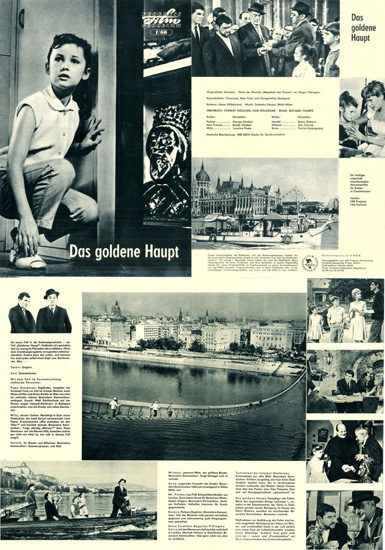 The original 4-page Progress Film Programme – top: Front and back pages, and
the text in the programme pages below informs about the movie's content. The original 4-page Progress Film Programme – top: Front and back pages, and
the text in the programme pages below informs about the movie's content."The Golden Head" was shown in the German Democratic Republic. It premiered in various East Berlin cinemas in 35mm CinemaScope film format on Friday, February 18, 1966. "The Golden Head", original title: "Az Aranyfej" - Based on the short novel "Nepomuk of the River" by Roger Pilkington Co-production: Cinerama, New York and Hungarofilm, Budapest Camera: István Hildebrand - Music: Szabolcs Fényes, Mitch Miller. (Author's comment: "Mitch Murray" is the correct name. In some sources Szabolcs Fényes is also called Peter Fényes) Screenplay: Stanley Goulder, Iván Boldizsár – Director: Richard Thorpe German translation: VEB DEFA-Studio for Synchronisation A Hungarian-American film for children in colour and in CinemaScope Parts: Actors: Palmer… George Sanders Harold… Denis Gilmore His friend… Buddy Hackett Michael… Jess Conrad Milly… Lorraine Power Anna… Cecilia Esztergalyos If you send in the return postage and the invoice amount beforehand, you will receive the required film programmes if they are still available, via the "Casino" cinema, 701 Leipzig 1, Neumarkt. You also have the possibility of purchasing older film programmes from your cinema or venue. You can purchase our programme booklets via mail subscription for a price per quarter of 3.20 MDN. Progress star photos are available from your cinema or in the relevant specialist stores at a price of 0.20 MDN per photo. Retail price 0.10 MDN. (Author's comment: The MDN, "Mark der Deutschen Notenbank", was cash in the German Democratic Republic from August 01, 1964 till December 31, 1967) Published by VEB Progress Film-Vertrieb, 102 Berlin, Burgstraße 27, Telephone: 42 59 71 |
|
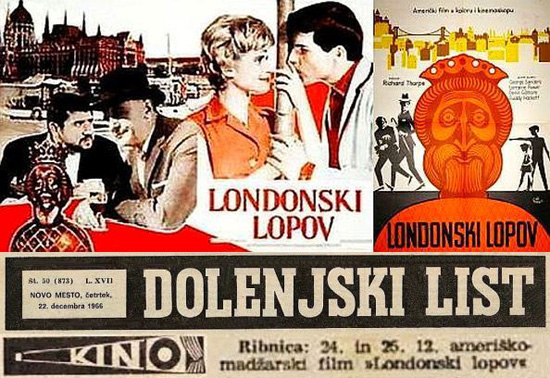 "The Golden Head" (Londonski Lopov) – Top: Film programme and poster. Below:
A newspaper information from that time. "The Golden Head" (Londonski Lopov) – Top: Film programme and poster. Below:
A newspaper information from that time. A short review about the movie from the Progress Film Press Office in the German Democratic Republic: "The Golden Head", the first co-production between Hungary and the USA – a crime film for children. For the first time in history, America's film makers made a trip across the pond to produce a film project in cooperation with a communist state. The result of the collaboration speaks for itself, particularly in view of the fact that it appeals to all age groups. "The Golden Head" unrolls as a widescreen, colourful crime caper for children, which also provides parents with an hour and a half of fun. The tale is perfectly suited for a co-production: A little steam ship is travelling down the Danube carrying an English father, who switches to four wheels as soon as he is over the border so that he can attend an Interpol convention being held in Budapest. And while he is in the conference room with his colleagues, discussing the troubles faced by criminologists in general and, more specifically, a duo of sinister antique thieves – his two children, who have been left alone on the boat, are already hot on the heels of the villains, who have stolen the golden head of Saint László, having realised the material value of the precious bust. Director Richard Thorpe chooses the majestic countryside along the banks of the Danube as the setting for his fun-filled pursuit, where he not only showcases the treasures of Hungarian culture, but also the customs of the country’s folklore. The crazy chase scenes are characterised by earthy humour, elements of slapstick comedy delight again and again and in the end, the only downside is a sense of regret that so few crime flicks for children are produced in a similar vein. At the time, the movie was also screened in 35mm CinemaScope film format in former Yugoslavia. Distributor: In the poster is written "Croatia Film". Title: "Londonski Lopov" (A Thief from London) "Američki film u koloru i kinemaskopu" is written in the poster. (An American film in Color and CinemaScope) "Dolenjski List" is a weekly newspaper published in Novo Mesto since 1950. Novo Mesto is a town located in the south-east part of Slovenia, approximately 60 km south-east of Ljubljana. According to the newspaper advert (see image) "The Golden Head" was shown in Ribnica on December 24 and 25, 1966. At last – now for the first time in the U.K.! "The Golden Head" presented in 70mm CINERAMA at London's Royalty Cinerama Theatre. It opened on Thursday, April 08, 1965, and ran for 8 weeks until Wednesday, June 02, 1965. |
|
 Top: Full page movie premiere advert in the British trade magazine "Films
and Filming" dated May 1965, and below: "The Golden Head" announcement in
London's newspaper "The Observer" from that time. Top: Full page movie premiere advert in the British trade magazine "Films
and Filming" dated May 1965, and below: "The Golden Head" announcement in
London's newspaper "The Observer" from that time.After Stanley Kramer's all-star epic comedy extravaganza "It's a Mad, Mad, Mad, Mad World" (USA, 1963) debuted "The Golden Head" at the Royalty Cinerama Theatre on 08.04.1965. As supporting film was shown Lothar Wolff's Oscar nominated short "Fortress of Peace" (Switzerland 1964) in 70mm Cinerama – in the author's opinion in some way inappropriate for a children's film as main feature. In the advert is written: CINERAMA presents an ideal holiday treat for the entire family! The Cinerama and Hungarofilms Presentation: You revel in a whirlwind of suspense and laughter! You are swept into the craziest treasure hunt ever for a king's ransom in gold! You join a hilarious laugh chase after two international crooks from London to Budapest and back! "The Golden Head" was unfortunately not deemed a success. William R. Forman of Pacific Theaters, one of the producers of the movie, had decided not to release the film in the U.S., and it had consequently been hidden away in a vault for a long time. It is reported that at the time only one 70mm print had been struck at Technicolor in London, and this print is now occasionally shown at widescreen festivals. A 70mm print is expensive. It costs about 6 to 8 times more than a 35mm print of the same film – much of this extra expense involves the magnetic striping for the soundtracks. But as a percentage of the total budget on a big picture, the purchase price of 70mm prints is not that significant. (Source: Trade magazine "Film Technology" – Viewpoints / Editorial Notes) William R. Forman also produced the 70mm Cinerama movie "Krakatoa, East of Java" (USA 1969). At the time, Forman held a top position in each of the three major industry branches: Production (film-making), distribution (film-marketing) and exhibition (theater ownership and management) and Cinerama was totally absorbed by Pacific Theatres. By the way, the volcanic island "Krakatoa" is located in the Sunda Strait west of Java. Shortly before the premiere, the producers noticed the geographic error – the movie's whole shooting took place in Europe. But after all of the advertising and publicity materials had been prepared it was deemed too costly to re-do these materials, also with the risk that the movie's premiere date would be postponed. The World Premiere took place at the Pantheon Theatre in Tokyo on Thursday, January 09, 1969. (Source: incinerama.com and the book: "Movie Roadshows / A History and Filmography of Reserved-Seat Limited Showings 1911-1973" by Kim R. Holston) |
|
Two reviews at the time of the movie's London premiere |
|
|
"New York VARIETY" dated Wednesday, April 14, 1965:
"The Golden Head" (Technirama-Color,
Hungarian-American) - Naďve mildly diverting cops-and-robbers comedy.
Pleasant to look at and okay for family audiences. Reviewed at Royalty Cinerama Theatre, London, Running Time 115 minutes. Originally planned as "Milly goes to Budapest" and skedded to star Hayley Mills, this co-production (Cinerama-Hungarofilm) filmed in 70mm Technirama is a naďve, mildly diverting piece of cops-and-robbery which is not a strong entry for Cinerama houses. But it will pleasantly entertain the indulgent. Direction by Richard Thorpe is slow-moving and unimaginative, and a more punchy script and brisker editing would have boosted the excitement. The hybrid cast, drawn from Amerika, Britain and local sources is uneven in quality but has not overmuch into which to get its teeth. There are some nice shots of Hungary which could give some pep to the tourist trade, but as a film for Cinerama audiences, now accustomed to such pictures as "How the West Was Won", "Brothers Grimm" and "The Greatest Story", it can only be looked upon as a theatre stopgap. Yarn concerns George Sanders and Buddy Hackett as a suave conman and stooge who try to lift the valuable Golden Head of St. Lazslo. But they are foiled by the amateur detective work of the amateur detective work of the children of a British police official who, with family, is in Budapest for a to level police conference. Events tend to meander along till the climax, which is a chase through Budapest involving the climbing of a suspension bridge, a speedboat dash on the Danube and a frenzied ride on a fire engine. But, with Thorpe's leisurely direction, even this finale doesn't add up to the pitch of excitement that might have been expected. Sanders, though getting a shade the better for such rushing about, plays his role with a mixture of debonair tongue-in-cheek and amusing self-consciousness. But the employment of Hackett as his dumb stooge fails to spark off much of a comedy team despite Hackett's determined mugging. Major honors are copped by moppet Lorraine Power, as the little girl who unwittingly starts all the bother. She is a wide eyed youngster, who is not too cutely precocious, and who engenders much amusement by the way she handles the detective routine. Cecilia Esztergalyos and Jess Conrad handle the slight romantic rather pallidly. But Denis Gilmore, who plays the Scotland Yard man with less aplomb than he is currently playing Sherlock Holmes on tele, is okay. Robert Coote gets a few jokes as a fatuous British Legation official. The Hungarian Folk Dancers and the Hungarian Opera Ballet make brief, but colorful appearances, the first at a village wedding and the second at a special gala performance, but both incidents have no bearing on the story. They are merely brought in to add to tourist interest, as are visits to a nightclub. The Technicolor shots are fine and art work and sound are also okay. But, overall, theatre patrons are less likely to be interested in whether or not Sanders gets away with his loot as whether or not Budapest and environs is likely to be a pleasant place for this year's vacation. (Rich.) |
|
|
A short review written by Robin Bean in the British trade magazine "Films
and Filming" dated June 1965: "I think I can see the Iron Curtain" says Milly the nine old Sherlock of the Danube as the White Rabbit cruises towards Budapest. Father (Douglas Wilmer, television's Sherlock) has gone off to a detectives` conference in the Hungarian capital, having secreted his tobacco in a cornflakes packet to evade the customs. The young girl now sets out to solve the mystery of the stolen Golden Head of Saint László lifted by two masterminds of art crimes (George Sanders and Buddy Hackett). It sounds for the most part like a children's serial. "The Golden Head" is a pathetic attempt at the first story film in one lens Cinerama (formerly titled "Milly goes to Budapest"). The best sequences, the "travelogue" of Budapest, are wrapped around the interval. It has quite a good chase sequence with fire-engine with George Sanders and Buddy Hackett holding grimly on the back, being pursued through the streets by two cars, but apart from that the film has little to recommend it. Showing with the film in London is "Fortress of Peace", a short which utilizes the visual effect of Cinerama very well. Directed by John Ferno (author's comment: Also named "John Fernhout"), it shows the Swiss army on military manoeuvres. The aerial shots of the Alps are beautiful, as in a strange way are those of the troops crossing the mountains in full pack. The mock battle scenes too are well shot: tanks smashing through the woods, flame thrower fired at the camera, a row of trees being felled by dynamite to block a road. In one shot the entire screen seems to disintegrate, as a cliff face is blasted. |
|
Cinerama in Budapest turns Winter to Summer |
|
|
Initially, the show faced a serious weather problem: The story was set in
summer and it was already October – but in November the weather became
acceptable. Here some information written in the movie's British Souvenir Brochure (16 pages, designed and printed by "The Upton Printing Group", Birmingham - London - Redhill): Budapest is blessed with many medicinal waters and hot springs, which have been put to good use since the days of the Romans in a number of huge, open-air swimming pools. And because of them, Cinerama brought a bit of summer to Budapest in winter. "Not to include one of the pools in our picture would be a great injustice to this beautiful city", said Richard Thorpe, director of "The Golden Head", when he viewed the immense outdoor pool of the deluxe Gellert Hotel. Told that it had been closed for the season – it was now a slightly blustery November – he added: "We´ll just have to pretend it's summer and open one." And in this way, one of the magnificent pools of the Hungarian capital is part of this tenth Cinerama production. Famed for centuries as one of Europe's most beneficial spas, Budapest has 117 thermal springs feeding its baths. These pump over 70.000.000 gallons of hot therapeutic liquid a day. The calcareous, sulphurated water is good for treatment of joint diseases, rheumatic pains, neuralgia, neuritis, chronic exudate, arthritis, paralysis, inflammations, heart diseases and neurasthenia, among other ailments. 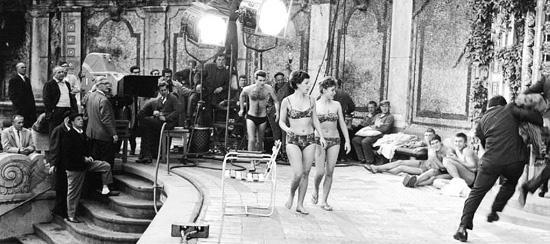 Budapest's famous Gellert bath. The pool sequences were filmed on a fairly
warm November day in 1963. Note the huge Technirama camera. Image taken from
the website of the "American Widescreen Museum" Budapest's famous Gellert bath. The pool sequences were filmed on a fairly
warm November day in 1963. Note the huge Technirama camera. Image taken from
the website of the "American Widescreen Museum"The particular day of the shooting of the pool sequences of the film – part of a hilarious chase of co-stars George Sanders and Buddy Hackett by a horde of children – turned out to be fairly warm, pleasant and windless one of 55 degrees Fahrenheit (12.8 degrees Celsius). 200 extras were hired to parade around in bikinis and other swim gear at the Gellert Greco-Roman pool, which can normally accommodate some 1000 people. The Gellert pool, which adjoins a similar sized indoor affair abounding with fun-and-health loving Budapestians, is not the largest in the Hungarian capital. Beautiful Margaret Island, situated in the Danube between Buda and Pest, boasts the Palatinus open-air baths which can easily accommodate 15.000 people. Supplied by two artesian wells, this pool covers an area of 70.000 square yards. Many of the baths, including the Kiraly, on the right bank of the Danube, have small tablets on the wall in different languages recording the grateful thanks of people from all over the world who were cured here. The Kiraly was originally built in 1560 during the Turkish occupation and served the Pasha and his retinue, as today it serves the local populace and hosts of visitors. Just as the waters cure people, the Gellert bath added one more enjoyable sequence to "The Golden Head", even though it may have been a wee bit out of seasons and Cinerama changed winter into summer. |
|
From the Mailbox of Hungarofilm |
|
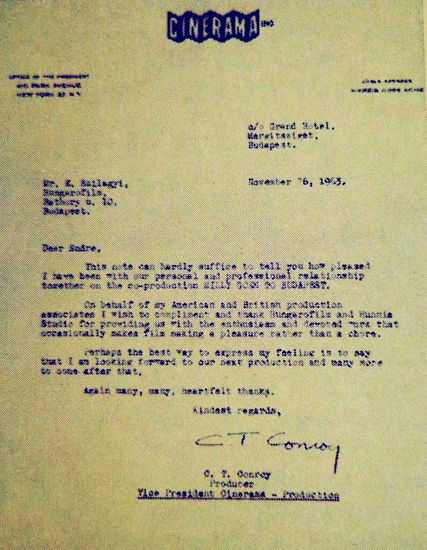 A letter written by the movie's Executive Producer, Coleman Thomas Conroy,
Jr., addressed to Mr. E. Szilágyi, who was at the time team leader of
Hungarofilm – published in "Hungarofilm Revue" No. 1 / 1965. A letter written by the movie's Executive Producer, Coleman Thomas Conroy,
Jr., addressed to Mr. E. Szilágyi, who was at the time team leader of
Hungarofilm – published in "Hungarofilm Revue" No. 1 / 1965.November 26, 1963 CINERAMA, Inc. Office of the President 410 Park Avenue New York, 22. N.Y. . Cable Address: Nikreis Code ACME Mr. E. Szilágyi Hungarofilm Báthory utca 10 Budapest Dear Endre, This note can hardly suffice to tell you how pleased I have been with our personal and professional relationship together on the co-production MILLY GOES TO BUDAPEST. On behalf of my American and British production associates I wish to compliment and thank Hungarofilm and Hunnia Studio for providing us with the enthusiasm and devoted more that occasionally makes film making a pleasure rather than chore. Perhaps the best way to express my feeling is to say that I am looking forward to our next production and many more to come after that. Again many, many, heartfelt thanks. Kindest regards… C. T. Conroy (Producer / Vice President, Cinerama-Production) Author's comment: In the movie's souvenir brochure is written that Coleman Thomas Conroy, Jr. had also worked on all nine previous 3-strip movies. Additional information from the author: Not as Executive Producer but as, e.g.: Technical Assistant on "Cinerama Holiday" (1955), from Production Staff on "Seven Wonders of the World" (1956), Production Manager on "How the West Was Won" (1962), Co-Producer on "The Best of Cinerama" (1962 – Merian C. Cooper's last film), as Camera Operator on "Windjammer" (1958), or later Producer on "Cinerama's Russian Adventure" (1966), and so on. "The Golden Head" was shown in Super Technirama-70 (print from Pacific Theatres, USA) at the Widescreen Weekend at the Pictureville Cinerama Cinema in Bradford (England) on Saturday, March 11, 2006. "The Golden Head" was shown in Super Technirama-70 at the 6th Todd-AO Film Festival at the Schauburg Cinerama Cinema in Karlsruhe (Germany) on Sunday, October 03, 2010 (with the presence of Jess Conrad – "Michael Stevenson" in the movie). "The Golden Head" received its much belated public Super Technirama-70 U.S. Premiere, only one performance, at the Arclight Cinerama Dome in Hollywood on Tuesday, September 8, 2009. …and on the occasion of Cinerama's 60th Anniversary its digital presentation, remastered from Technirama and M.C.S. 70 negatives, on Saturday, September 29, 2012. Last but not least, some information taken from the book "Wide Screen Movies" by Robert E. Carr and R.M. Hayes (ISBN 0-89950-242-3): "The Golden Head": 70mm Roadshow version: RCA 6-track magnetic stereophonic sound / AR: 2.20:1 / Running time: 115 minutes (author's comment: Most likely here with included Overture, Entr´acte and Walk Out music – the 70mm version has an intermission). Filmed at Budapest Studio and on location in Budapest, Szentendre and Esztergom and on the Danube River in Hungary, completed at Shepperton Studios (author's comment: Located southwest of London). Hungarian "Az Aranyfej" version: Running time 102 minutes. Filming process began in 3-strip Cinerama process but this was canceled and they switched to 8-perf 35mm Technirama shooting. |
|
A short Epilogue by the Author |
|
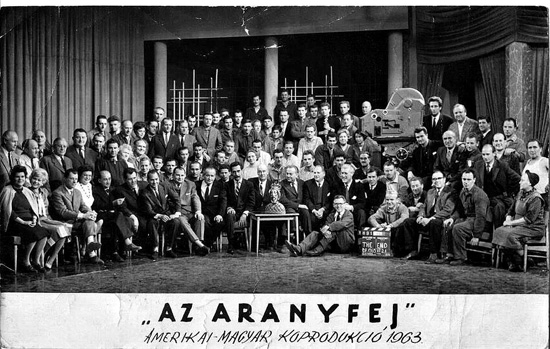 "The End" – principal shooting of "Az Aranyfej" (The Golden Head) ended in
Hungary on Thursday, November 21, 1963 (see movie clapper – just to remind:
On following day John F. Kennedy was assassinated in Dallas), and now a last
meeting. Image taken from the informative Hungarian website: "MAGYAR FOTÓARCHÍVUM" "The End" – principal shooting of "Az Aranyfej" (The Golden Head) ended in
Hungary on Thursday, November 21, 1963 (see movie clapper – just to remind:
On following day John F. Kennedy was assassinated in Dallas), and now a last
meeting. Image taken from the informative Hungarian website: "MAGYAR FOTÓARCHÍVUM"Meanwhile, David Strohmaier / Randy Gitsch have remastered the whole movie and I am still hoping that it will be published on Blu-ray sometime. I saw "Milly" for the first time at Bradford's Widescreen Weekend in 2006. It was well received. Some opinions about the movie read as follows: An unexpected delight that was a great deal better than its reputation. "The Golden Head" was the great surprise and a real treat. Excellent! Great to see the legendary "The Golden Head"! I especially like the picturesque Budapest / Danube shots by cinematographer István Hildebrand and the musical score by Szabolcs Fényes. Yes, it is only a naďve `cops-and-robbers comedy´, but pleasant to look at and okay for family audiences and children and no more. By the way, filming in Hungary has been prospered more and more. Have a look at the website of the famous Korda Studios – a state-of-art film studio complex located 30 km (18 miles) west of Budapest. It is named after Sir Alexander Korda (1893 – 1956), a well-known Hungarian-born British film producer and director. Ridley Scott's newest movie "The Martian" (USA, 2015) was shot here. They also decided to film in Budapest because the studio has one of the biggest soundstages in the world (Studio 6, some 64.300 sq ft). They used tons of Hungarian soil in order to build a Mars plain. Limited filming took also place at Wadi Rum in Jordan (Lawrence of Arabia, UK, 1962). Production was also permitted to film rocket launches at Cape Canaveral, e.g., the lift off of ORION's first flight test on Friday, December 05, 2014. |
|
| Go: back - top - back issues - news index Updated 22-01-25 |
